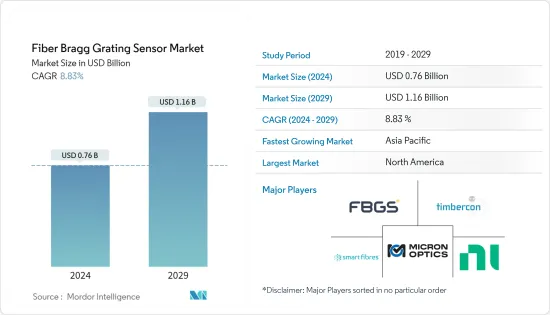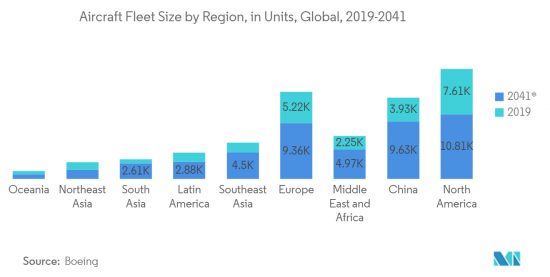 |
市場調查報告書
商品編碼
1406269
FBG 感測器:市場佔有率分析、行業趨勢/統計、成長預測,2024-2029 年Fiber Bragg Grating Sensor - Market Share Analysis, Industry Trends & Statistics, Growth Forecasts 2024 - 2029 |
||||||
※ 本網頁內容可能與最新版本有所差異。詳細情況請與我們聯繫。
FBG感測器市場規模預計到2024年為7.6億美元,預計到2029年將達到11.6億美元,在預測期內(2024-2029年)複合年成長率為8.83%,預計。

主要亮點
- FBG 技術由於其易於製造、相對強大的反射訊號強度和操作彈性,已成為普及的溫度和應變測量光纖感測器。
- FBG 感測器是透過沿其長度週期性地調變纖芯的屈光而形成的。透過仔細確定結構,可以為光纖付加各種感測功能。輸出的波長編碼特性允許透過將每個感測器分配到可用頻譜的不同波長範圍來使用分波多工(WDM)技術。這些功能有利於市場成長,因為校準用於確定物理量和波長之間的對應關係,是影響感測器性能的關鍵因素之一。
- 此外,比其他感測器更長的使用壽命也是支持市場成長的主要因素。根據同行評審的開放獲取科學期刊出版商 Hindawi 介紹,壽命預測模型表明,在基於 FBG 的鋼絞線在工作環境中承受的壓力條件下,FBG 感測器在無壓力情況下的基本估計監測條件是壽命約為56至27年。
- FBG 利用單一光纖測量各種參數(例如應變、壓力和溫度)的固有能力增加了其在各個最終用戶行業中的需求。此外,具有相對低成本 FBG 的多點感測陣列提供了較高的設計彈性,使其成為各種感測應用的理想設備。
- FBG 感測器在建築和航空領域比傳統的結構監測設備具有許多優勢。然而,根據使用案例,存在成本和技術限制,這構成了阻礙普及和成長的重大課題。
- 在所研究的市場中,COVID-19 大流行的影響顯而易見。在早期階段,由於嚴格的封鎖措施難以確保原料/零件的供應,製造商面臨全球供應鏈的中斷。然而,隨著局勢正常化以及主要最終用戶產業進一步擴大業務,這些感測器的需求預計將在後疫情時期成長。
FBG感測器市場趨勢
航太作為 FBG 感測器的最終用戶正在迅速成長
- 事實證明,FBG 感測器是需要高精度、遙感和輕型感測器的航太工程相關應用的理想選擇。該技術用於多種應用,包括高壓感測、地面空氣動力測試設施、衝擊壓力感測、太空船監測和飛機複合複合材料的結構健康監測。
- 它還在航太工業的許多應用中發揮重要作用,主要用於監測飛機機翼和飛機疲勞。它也用於製造飛機和空間結構的智慧複合材料。此外,惡劣而複雜的操作環境是航太的特點,選擇能夠承受此類極端外部環境並以所需的準確度、可靠性、精密度和可重複性運行的合適感測器對於行業參與者來說至關重要。
- 多家飛機製造商已成功使用該技術。例如,瑞典航太公司 SAAB 使用光纖感測器系統過熱檢測系統 (OHDS) 即時監控引氣管路,以偵測熱空氣洩漏。據該公司稱,FBG 感測器技術提供真實的溫度測量,具有設定警報閾值、追蹤趨勢和引入智慧警報功能等功能。
- 此外,預計飛機製造的增加將在預測期內推動市場成長。例如,根據日本飛機開發公司 (JADC) 的數據,空中巴士公司是最大的民航機製造商之一,去年交付了611噴射機。預計在預測期內將保持成長軌跡。波音公司的主要競爭對手去年為其全球持有增加了 340噴射機。如此大規模的飛機製造將帶動FBG感測器市場的需求。
- 此外,各地區機持有數量的增加預計也將推動航太對FBG感測器市場的需求。例如,據波音公司稱,預計到 2041 年,北美地區將擁有約 10,810 架飛機,成為全球最大飛機機隊的持有。

亞太地區預計將錄得最快成長
- 由於中國、印度、日本和韓國等新興國家的快速工業化,亞洲對光纖光柵感測器的需求在預測期內將增加。基於 FBG 的溫度、壓力和應變等感測器廣泛應用於水處理和服務、石油和天然氣、採礦和發電等製程控制產業。
- 中國、印度和印尼等政府正在採取舉措支持製造業的成長,為市場創造進一步的成長機會。例如,2022年10月,中國宣布了多項允許外資進入製造業的措施。中國政府表示將促進外國製造企業的進出口,並在貿易和通關方面提供支援。國家統計局數據顯示,2022年9月中國工業增加價值年增6.3%。
- 該地區也是日本、印度和中國等一些世界最大發電國的所在地。例如,印度將於2022年成為世界第三大發電國。 (資料來源:世界人口評論)。 IBEF預計,2022會計年度印度發電容量將增加至近400吉瓦。
- 此外,由於光纖光柵感測器廣泛應用於飛機中,印度民航業的成長預計也將推動市場成長。根據印度品牌股權基金會 (IBEF) 的數據,國內航班約佔南亞航空運輸量的 69%。預計到2023年,印度機場的容量將達到每年10億架次航班。印度目前是全球第七大民航市場,預計未來十年內將成為第三大民航市場。
FBG感測器產業概況
FBG 感測器市場的特點是多元化,以 FBGS International NV、Smart Fibers Ltd、Micron Optics (Luna Innovations)、Timbercon Inc. 和 National Instruments Corporation 等知名企業為中心。市場參與企業正在策略性地採取合作和收購等策略,以加強產品系列建立永續的競爭優勢。
其他福利:
- Excel 格式的市場預測 (ME) 表
- 3 個月分析師支持
目錄
第1章簡介
- 研究假設和市場定義
- 調查範圍
第2章調查方法
第3章執行摘要
第4章市場洞察
- 市場概況
- 產業吸引力-波特五力分析
- 新進入者的威脅
- 買方議價能力
- 供應商的議價能力
- 替代品的威脅
- 競爭公司之間敵對關係的強度
- 產業價值鏈分析
- COVID-19 對產業的影響
第5章市場動態
- 市場促進因素
- 飛機上的使用增加
- 內建校準工件和更長的使用壽命
- 市場抑制因素
- 熱靈敏度和橫向應變靈敏度
第6章市場區隔
- 依類型
- 溫度感應器
- 應變感測器
- 壓力感測器
- 其他
- 依最終用戶產業
- 通訊
- 航太
- 建築/基礎設施
- 能源/電力
- 礦業
- 其他
- 依地區
- 北美洲
- 歐洲
- 亞太地區
- 其他地區
第7章 競爭形勢
- 公司簡介
- FBGS International NV
- Smart Fibres Ltd
- Micron Optics(Luna Innovations)
- Timbercon Inc.
- National Instruments Corporation
- HBM Inc.(An HBK Company)
- Broptics Technology Inc.
- ITF Technologies
- Advanced Optics Solutions(AOS)GmbH
- Technica Optical Components LLC
第8章投資分析
第9章 市場機會及未來趨勢

The Fiber Bragg Grating Sensor Market size is estimated at USD 0.76 billion in 2024, and is expected to reach USD 1.16 billion by 2029, growing at a CAGR of 8.83% during the forecast period (2024-2029).
Key Highlights
- Fiber Bragg grating (FBG) technology is becoming a popular choice for optical fiber sensors for temperature or strain measurements because of their simple manufacture, relatively strong reflected signal strength, and operational flexibilities.
- A periodic modulation of the refractive index of the fiber core along the longitudinal direction forms fiber Bragg grating sensors. Various sensing functionalities can be added to the optical fiber by carefully determining the structure. The wavelength-encoded nature of the output allows the use of the wavelength division multiplexing (WDM) technique by assigning each sensor to a different wavelength range of the available light source spectrum. As calibration is used to determine the mapping relationship between the physical quantity and wavelength and is one of the critical factors affecting the sensor's performance, such a feature favors the market's growth.
- Furthermore, a longer lifetime than other sensors is another major factor supporting the market's growth. According to Hindawi, a publisher of peer-reviewed, open-access scientific journals, the life-prediction model indicates that the estimated monitoring life of an FBG sensor in an unstressed condition is about 56 and 27 years under the stressful situations that fiber Bragg grating (FBG)-based steel strands are subjected to in their working environment.
- Owing to their intrinsic capability to measure a variety of parameters, such as strain, pressure, temperature, and many others, along a single fiber, their demand has been increasing across various end-user industries. Additionally, these multi-point sensing arrays of many relatively low-cost FBGs also provide great flexibility of design, making them ideal devices to be adopted for a multitude of different sensing applications.
- Fiber Bragg grating sensors have many advantages over traditional and structural monitoring devices in the building and aviation sectors. However, cost and technological limitations in some use cases are among the significant factors challenging their widespread adoption and growth.
- A notable impact of the COVID-19 pandemic was observed in the market studied. During the initial phase, the manufacturers faced difficulties in securing the supply of raw materials/components due to stringent lockdown measures, which disrupted the supply chain globally. However, with the condition normalizing and major end-user industries expanding their operations further, the demand for these sensors is expected to grow during the post-COVID period.
Fiber Bragg Grating Sensor Market Trends
Aerospace to be Among the Fastest Growing End User for FBG Sensors
- Fiber Bragg grating sensors have proven ideal options in aerospace engineering-related applications requiring high precision, remote sensing, and lightweight sensors. This technology is used in a variety of applications, including high-pressure sensing, ground-based aerodynamic test facilities, shock pressure sensing, spacecraft monitoring, and structural health monitoring of aircraft composites.
- It also has significant uses in the aerospace industry, mainly for airplane wing monitoring, fuselage fatigue, and many others. Also, they have been used in smart composite manufacturing for aircraft and space structures. Furthermore, a harsh and complex operating environment characterizes the aerospace industry, and choosing a suitable sensor to withstand such external environment extremities and perform at the desired accuracy, reliability, precision, and repeatability is of prime importance for the players in the industry.
- Several aircraft-making companies are successfully using this technology. For instance, SAAB, a Swedish aerospace company, uses a Fiber Optic Sensor System Overheat Detection System (OHDS) for real-time monitoring of bleed air piping to detect hot air leakage. According to the company, FBG sensor technology provides actual temperature measurements with the ability to set alarm thresholds, trace trends, and introduce smart alarm functions.
- Furthermore, a rise in aircraft construction is expected to bolster the market's growth during the forecast period. For instance, according to Japan Aircraft Development Corporation (JADC), Airbus is one of the largest commercial aircraft manufacturers, delivering 611 jets last year. It is expected to maintain its growth trajectory during the forecast period. Boeing's main competitor added 340 jets to the global aircraft fleet last year. Such massive aircraft manufacturing will drive the demand for the Fiber Bragg Grating sensor market.
- The growing aircraft fleet size across various regions is also anticipated to drive the demand for the fiber Bragg grating sensors market in the aerospace industry. For instance, according to Boeing, the North American region is anticipated to lead the charts of the largest aircraft fleets in the world, with about 10,810 aircraft in its fleet by 2041.

Asia Pacific is Expected to Register Fastest Growth
- The demand for fiber Bragg grating sensors in Asia will increase over the forecast period due to rapid industrialization in emerging countries, such as China, India, Japan, and South Korea. Fiber Bragg grating-based sensors, such as temperature, pressure, strain, and others, are widely used in process control industries such as water treatment and services, oil and gas, mining, and power generation.
- The governments in countries such as China, India, and Indonesia, among others, are taking the initiative to support the manufacturing industry's growth, further creating growth opportunities for the market. For instance, in October 2022, China announced several measures to enable foreign investment in the manufacturing industry. The Chinese government stated that it would facilitate imports and exports of foreign-invested manufacturing firms and provide assistance regarding trade and customs clearance. According to the National Bureau of Statistics, China's industrial output increased by 6.3% year-on-year in September 2022.
- The region is also home to some of the largest power-generating countries in the world, like Japan, India, and China. For instance, India emerged as the third-largest electricity-generating country in the world in 2022. (Source: World Population Review). As per IBEF, in the financial year 2022, India's power generation capacity rose to nearly 400 gigawatts.
- Furthermore, the growing civil aviation industry in India will also fuel the market growth as fiber Bragg grating sensors are widely used in aircraft. According to the India Brand Equity Foundation (IBEF), domestic traffic contributes around 69% of the total airline traffic in South Asia. India's airport capacity is expected to handle 1 billion trips annually in 2023. India is currently the 7th largest civil aviation market in the world and is expected to become the third-largest civil aviation market within the next 10 years.
Fiber Bragg Grating Sensor Industry Overview
The Fiber Bragg grating sensor market is characterized by a diverse landscape, featuring prominent players such as FBGS International NV, Smart Fibres Ltd, Micron Optics (Luna Innovations), Timbercon Inc., and National Instruments Corporation. Market participants are strategically employing tactics like partnerships and acquisitions to bolster their product portfolios and establish a sustainable competitive edge.
In January 2023, Technica Optical Components marked a significant achievement by successfully manufacturing their one millionth FBG sensor. The company offers an extensive range of FBG products, encompassing FBG sensors, FBG arrays and cables, as well as FBG packaged sensors, positioning the company as a leading provider of fiber Bragg grating sensors.
In December 2022, Technica Optical Components introduced a new line of Fiber Bragg Grating-based Temperature Sensors engineered for operation in cryogenic environments. These sensors feature an advanced unibody micro-structured design, specifically optimized for precise temperature measurements in ultra-low temperature settings. The technology leverages high-precision, advanced cryogenic-rated materials and incorporates Technica-manufactured FBGs within the fiber cores to deliver a transducer configuration characterized by exceptional precision, resolution, and repeatability.
Additional Benefits:
- The market estimate (ME) sheet in Excel format
- 3 months of analyst support
TABLE OF CONTENTS
1 INTRODUCTION
- 1.1 Study Assumptions and Market Definition
- 1.2 Scope of the Study
2 RESEARCH METHODOLOGY
3 EXECUTIVE SUMMARY
4 MARKET INSIGHTS
- 4.1 Market Overview
- 4.2 Industry Attractiveness - Porter's Five Forces Analysis
- 4.2.1 Threat of New Entrants
- 4.2.2 Bargaining Power of Buyers
- 4.2.3 Bargaining Power of Suppliers
- 4.2.4 Threat of Substitute Products
- 4.2.5 Intensity of Competitive Rivalry
- 4.3 Industry Value Chain Analysis
- 4.4 Impact of COVID-19 on the Industry
5 MARKET DYNAMICS
- 5.1 Market Drivers
- 5.1.1 Increasing Usage in the Aircraft
- 5.1.2 Built-in Calibration Artifacts and Longer Lifetime
- 5.2 Market Restraints
- 5.2.1 Thermal and Transverse Strain Sensitivity
6 MARKET SEGMENTATION
- 6.1 By Type
- 6.1.1 Temperature Sensor
- 6.1.2 Strain Sensor
- 6.1.3 Pressure Sensor
- 6.1.4 Other Types
- 6.2 By End-user Industry
- 6.2.1 Telecommunication
- 6.2.2 Aerospace
- 6.2.3 Construction and Infrastructure
- 6.2.4 Energy and Power
- 6.2.5 Mining
- 6.2.6 Other End-user Industries
- 6.3 By Geography
- 6.3.1 North America
- 6.3.2 Europe
- 6.3.3 Asia-Pacific
- 6.3.4 Rest of the World
7 COMPETITIVE LANDSCAPE
- 7.1 Company Profiles
- 7.1.1 FBGS International NV
- 7.1.2 Smart Fibres Ltd
- 7.1.3 Micron Optics (Luna Innovations)
- 7.1.4 Timbercon Inc.
- 7.1.5 National Instruments Corporation
- 7.1.6 HBM Inc. (An HBK Company)
- 7.1.7 Broptics Technology Inc.
- 7.1.8 ITF Technologies
- 7.1.9 Advanced Optics Solutions (AOS) GmbH
- 7.1.10 Technica Optical Components LLC










